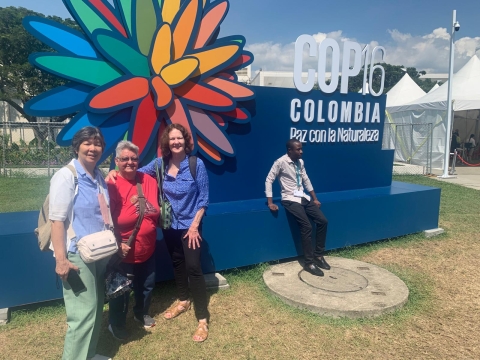
Hosting a record-breaking 23,000 attendees, the conference was filled with representatives seeking solutions. While we await the outcome, we review what is at stake.
The following article was published in the November-December 2024 issue of NewsNotes.
Parties to the UN Convention on Biological Diversity descended on Cali, Colombia, from October 21 to November 1 to work towards international partnership on preserving biodiversity. While we do not yet have the conference outcome, the stakes of the conference are clear. The rich diversity of creation is at risk. The exploitation of natural resources, overconsumption, land-use changes, and environmental pollution harm the biodiverse ecosystems we are meant to steward.
Since 1970, we have seen a 69% decrease in global wildlife populations, a reality that will lead to the threat of extinction for one million species within the next few decades if nothing is done. Indigenous people have been the best stewards of biodiversity, and over 80% of the remaining biodiversity is on their lands. Yet, hostility from extractive companies and conservation efforts to displace people threaten the symbiotic relationship between these people and their land.
During the previous biodiversity conference, progress was made with the 2022 Kunming-Montreal Global Diversity Framework (KMGBF) that introduced The Biodiversity Plan, conserving 30% of the earth’s land and water, restoring 30% of degraded ecosystems, and decreasing the introduction of invasive species by 50%, all by 2030. This conference this year seeks to take concrete steps towards the implementation of these goals.
The theme for this year's biodiversity conference is "Peace with Nature," and delegations from over 190 countries convened in Colombia to discuss the necessity of a unified global response to biodiversity loss. This convention grew out of the 1992 Earth Summit in Rio de Janeiro, Brazil, which called upon the world to address, halt, and reverse the global loss of biodiversity.
Colombia, one of the most biodiverse countries on the planet is home to 54,000 recognized species. Indigenous peoples, an important voice in the conversation, largely protect the country’s Amazon rainforest. While the Colombian government pushes an ambitious climate plan to phase out fossil fuels, transition to clean energy, and end national deforestation by 2030, controversy has arisen over its neglect of protecting environmental defenders. Colombia had the highest number of assassinations of environmental activists in the world in 2023, as document by Global Witness, with organized crime believed to be responsible for around half of those.
Hosting a record-breaking 23,000 attendees, the biodiversity conference was filled with representatives seeking solutions. Official delegations from countries who are parties to the Convention were expected to present plans of action to achieve the 30x30 goals outlined in the KMGBF. The U.S. is not a party to the Convention. Efforts have been made by most U.S. presidents since 1992 to join, but international treaties require a two-thirds Senate majority, which has not been achieved.
Others attending included Indigenous representatives of communities across the globe who voiced their concerns, sharing insights and knowledge from their relationship with biodiverse lands. Accredited observers were invited to the conference, representing faith organizations, civil society, activists, students, politicians, and Maryknoll missioners.
Maryknoll Office for Global Concerns hosted a side event, “Strengthening Indigenous and Local Community Partnerships” featuring Maasai pastoralists from Tanzania and community leaders from the Colombian Amazon.
Maryknoll representatives to the UN and other members of faith communities advocated for the following outcomes to be generated by the UN Biodiversity Conference:
- The protection of environmental defenders advocating for land and water protection, focusing on advocates in Latin America threatened with significant violence.
- The assurance of leadership from Indigenous and local communities in biodiversity conservation. Eighty percent of the remaining biodiversity on the planet is on their traditional lands making it imperative to respect and protect both their right to stay on their land and to assume leadership in its protection.
- The ambitious implementation of the Kunming Montréal Global Biodiversity Framework (KMGBF) that aims to halt and reverse biodiversity loss. Priority should be given to submissions of National Biodiversity Strategies and Action Plans.
- To address biodiversity loss and climate change at the same time, with combined efforts to restore biodiverse ecosystems while mitigating the effects of climate change, integrating policies at national and international levels.
- To ensure adequate funding for biodiversity conservation, expanding access to resources, and advocating for increased financing from developed countries, including $20 billion from the U.S. by 2025.
Photo of Maryknoll Sisters Margaret Lacson and Dee Smith and Maryknoll Office for Global Concerns Integral ecology senior program officer Lisa Sullivan at the Cali, Colombia, COP16 Biodiversity Conference courtesy of Lisa Sullivan.
